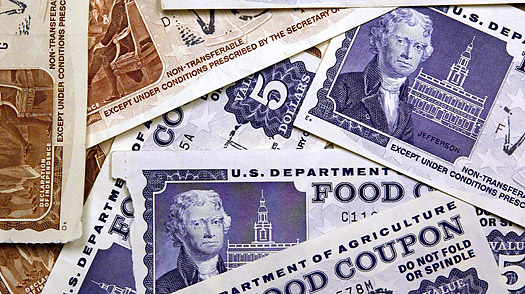
This program, historically and commonly known as the Food Stamp Program is a federal-assistance program that provides assistance to low and no-income people and families living in the U.S. Today, all food-stamp benefits are distributed using cards but for most of its history, the program had actually used paper denominational stamps or coupons worth from $1 to $10. In the late 1990s, the food-stamp program was revamped and actual stamps were phased out in favor of a specialized debit-card system known as Electronic Benefit Transfer (EBT) provided by private contractors.
The number of Americans receiving food stamps reached 43 million in November 2010, the highest number since the program began in 1939. In Washington, D.C. and Mississippi, more than one-fifth of the residents receive food stamps. As of June 2009, the average monthly benefit was $133.12 per person. Currently, one in eight Americans and one in four children are using food stamps and the program rate is growing at 20,000 people per day! Recipients must have at most near-poverty incomes to qualify for benefits.
The first recipient on May 16, 1939 was a Mabel McFiggin of Rochester, New York. The program operated by permitting people on relief to buy orange stamps equal to their normal food expenditures – for every $1 worth of orange stamps purchased, fifty-cents worth of blue stamps were received. Orange stamps could be used to buy any food; blue stamps could be used only to buy food determined by the Department of Agriculture to be surplus. The program ended in the Spring of 1943 when the conditions that brought the program into being, unmarketable food surpluses and widespread unemployment, no longer existed.
The program has survived numerous changes with the Food Stamp Act of 1964 and then the Food Stamp Act of 1977. According to the United States Department of Agriculture based upon data gathered in 2006: 49% of all participants are children under 17 years; 52% of all food stamp households include children; and 33% of households with children were headed by a single parent. According to the Government Accountability Office, only 3.53% of food stamp benefits were found to be overpaid and 66% of all improper payments were the fault of the caseworker, not the participant. Some fraud has been identified by people using their food stamp benefits to buy tobacco and alcohol.
With the dire financial straits of the Obama Administration, the future of the Food Stamp Program is in jeopardy. Congress has already started cutting some food programs including reducing the Women, Infants and Children Program by $500 million dollars as part of a deal on this year’s budget. This is in addition to $2 billion dollars in future funding for the food stamp program being redirected to other programs. There is little doubt that the food stamp program as it exists now will survive the surgical cuts planned by Congress. As Budget Committee Chairman Rep. Paul Ryan of Wisconsin said, “You just don’t want to do it with a meat cleaver.”








